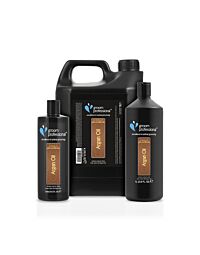
When you're used to getting countless curly cockapoos or lots of smooth-coated serial shedders in your salon, the thought of a long-haired breed can be quite daunting. But not to fret; I'm here to help!
Some long-haired breeds are:

These are only a few examples of many of the luscious long-coated breeds. Although any long-coated dog is going to be high maintenance, you will notice I have categorized them into single coat VS. double coat.

Single Coat
A single-coated breed only has one layer of fur, meaning there is no undercoat lying beneath the topcoat. In my experience, single coated, long-haired dogs tend to struggle with greasy coats, so I would highly recommend bathing them in the . This, for me, is the best shampoo I have used to break down grease in coats.
The right kind of conditioner is also essential for a long-haired breed as it coats the hair and smooths the hair shaft, allowing the hairs to slide apart from each other and thus, preventing tangling. I would recommend the as it leaves the coat looking tremendously healthy and shiny. Just remember not to overdo it with the conditioner and make sure it is rinsed thoroughly as this can be the difference between a greasy coat and a nice healthy shiny one!
One of my favourite tools when it comes to brushing the long-haired breeds is my . I usually use the wider end of the comb when I first begin to go through the coat and then double-check, I haven't missed any knots or tangles with the thinner end of the comb. Another trusty steed to add to your long-haired grooming kit would be the good old de-matting comb. I don't think I could survive without having one of these in my grooming kit. They easily slice through mattes, making it much quicker, easier, and pain-free to get through.

Double Coat
A common problem I find long-haired, double-coated breeds struggling with is their coat becoming compacted. This is when the undercoat becomes tangled with the long topcoat of the dog which then doesn't allow them to freely shed their undercoat. Some products and tools I like to use when treating a dog for this:
You will want to get yourself a good deshedding shampoo and conditioner. I use the and . I start by massaging the conditioner onto the DRY coat and then blasting it through the coat with my high velocity dryer. Let it sit, then rinse, apply your shampoo, let it sit then blast through the coat again. You will want to repeat this process until you see the undercoat start to loosen and blast out from beneath the topcoat. It is also worth noting that the better the shampoo penetrates the pup's skin, the looser the stubborn hair will become; will also help aid this. It might take a while but trust the process!
Once you have successfully bathed the dog and loosened up its coat, I recommend using the . This spray has been a game changer for me when it comes to drying long-haired dogs! I don't know how I ever groomed without this, and it smells amazing! When it comes to brushing out the remainder of the undercoat, a rake is your best friend. This will remove any undercoat that may be hidden in the top layer also. Once you are confident you have removed all undercoat, it is good to go through the coat again with a comb. Likewise, with the long-haired, single-coated dogs, I recommend the spectrum 50/50 comb. Not only will this leave that lovely, long, luscious coat with a silky/fluffy finish; but it will also ensure all remaining debris and tangles have been banished.
Hopefully now when you are faced with a long-haired breed in your salon you are a bit more confident. Just remember to encourage the owners that regular and frequent grooming appointments are a must for their high maintenance pup!



















